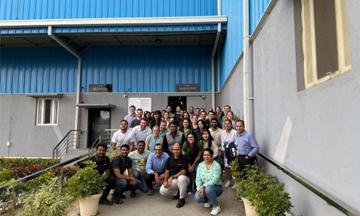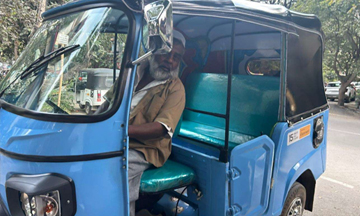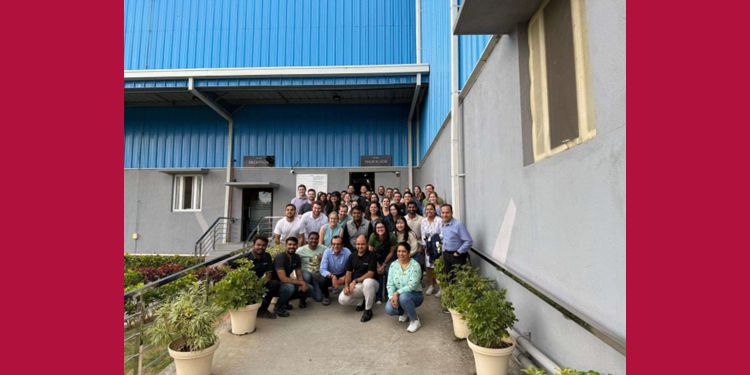Professor Vikram Gandhi’s Immersive Field Course (IFC) “Development while Decarbonizing: India’s Path to Net-Zero" delved into the critical aspect of decarbonization and sustainability goals amid India's rapid development. The course presented an opportunity for students to advance their knowledge of sustainability efforts, decarbonization, and net zero in the context of a broader development agenda. The class culminated in a series of site visits in January 2025 in Mumbai and Bangalore and this is one of 9 student essays that highlights their reflections on uncovering sustainable solutions across the country.
This January, as part of Harvard Business School's lmmersive Field Course (IFC) in India on "Decarbonizing While Developing," we had the privilege of exploring how various industries are tackling the dual challenges of achieving economic growth while advancing toward India's net-zero goals.
Transportation is one of the largest contributors of carbon emissions in India. With 300 million 2- wheelers on the road, the vast majority powered by internal combustion engines (ICE), the decarbonization of 2-wheelers-and the broader mobility sector-presents a tremendous opportunity for reducing emissions. Our research focused on understanding the opportunities and hurdles faced by emerging 2-wheeler EV manufacturers and advancements in EV battery and charging technologies and infrastructure.
As part of this research, we spent a full day visiting Ather Scooter and Exponent Energy, two companies that are working on the forefront India's journey towards electric vehicles. These visits provided an intimate look at how startups are tackling some of the most pressing challenges in EV adoption. The experience wasn't just about learning the technical and market dynamics; it was a crash course in understanding what it takes to make EVs viable, scalable, and deeply relevant in the uniquely Indian context.
Ather Scooter
Our first stop was Ather Scooter, where we toured their Tamil Nadu factory, home to both battery pack and scooter assembly lines. Founded by Tarun Mehta and Swapnil Jain a decade ago, Ather has grown from a battery R&D startup to a market leader in electric 2-wheelers, now commanding 30% market share in new electric scooter sales. This achievement puts them ahead of several larger, well-funded competitors, despite having a smaller distribution footprint and only three product offerings.
In a presentation by Ather's CEO, we gained insights into their strategy for winning market share from internal combustion engine (ICE) scooters as well as their e-scooter competitors. Their approach not only accelerates EV adoption in the 2-wheeler segment but also positions them as leaders in decarbonizing India's mobility sector, offering several key insights for our research.

Switching from ICE to Electric with Premium Products
Ather drives the customers transition from ICE scooters to electric by offering premium models like the 450X and Rizta, featuring touchscreen dashboards, WhatsApp navigation, and live location sharing. Their focus on performance and technology appeals to customers upgrading from traditional two-wheelers, proving that quality products can drive EV adoption beyond affordability.
Leading Through Innovation and Safety
With 8-year battery warranties, a spotless safety record, and innovative products like the Halo Smart Helmet, Ather prioritizes trust, convenience and better overall experience. This focus on reliability and technology sets them apart in a competitive EV market, ensuring their customers see clear value in choosing electric over ICE vehicles and their e-scooters over other's e-scooters.
Building a Charging Ecosystem
Ather Grid, with over 2,500 fast chargers, addresses charging anxiety and supports seamless EV adoption. By making their charging standards interoperable, they foster collaboration and ensure their infrastructure benefits not only Ather users but also other EV owners, creating a robust ecosystem for even greater e-scooter adoption.
Inclusivity as a Growth Driver
By staffing 70% of its battery production workforce with women, Ather challenges traditional manufacturing norms and promotes inclusivity. This commitment to diversity reflects a broader goal of aligning the green transition with social impact and equity.
Exponent Energy
Exponent Energy is addressing one of the key challenges of EV adoption-charging time-by developing technology that can charge a vehicle to 85% in 15 minutes. Their focus is primarily on commercial vehicles (CVs), a segment that represents 10% of India's vehicles but consumes 70% of the energy used in mobility. During our visit, we attended a presentation by their CEO and observed a live demonstration of their charging system, where a commercial 3-wheeler was charged to 85% capacity in just 15 minutes. Below are the key takeaways from the visit:

Solving Barriers to EV Adoption with Fast Charging
Exponent Energy's 15-minute fast-charging technology, which charges a vehicle to 85%, addresses critical concerns like range anxiety and downtime. By drastically reducing charging times, their solution ensures vehicles spend more time operational, making EVs a practical alternative to internal combustion engine (ICE) vehicles. This is particularly significant for commercial fleets, where uptime directly impacts profitability.
Strategic Focus on Commercial Vehicles
Exponent's priority on 3-wheelers and other commercial vehicles reflects the segment's high energy consumption and crucial role in urban logistics. Rapid charging eliminates the need for battery swapping or extended downtimes, allowing fleet operators to maximize operational efficiency. This approach aligns with the needs of densely populated Indian cities, where commercial vehicles are integral to transportation and logistics.
Ecosystem Enablement for OEMs
Beyond charging stations, Exponent is enabling OEMs to adopt advanced battery technology and integrate seamlessly with its charging network. This ecosystem approach accelerates the transition to EVs for OEMs by reducing the need for significant infrastructure build-up, making it easier for manufacturers to transition to better EV platforms.
Tailored Solutions for India's Market
The live demonstration of 85% charging in 15 minutes showcased the feasibility and scalability of Exponent's technology. Designed for India's specific challenges-such as voltage fluctuations, dust, and high utilization demands-their solutions provide reliable performance, suggesting a viable pathway for the scalable adoption of EVs in the commercial segment.
Conclusion
Ather Scooter and Exponent Energy, while addressing different facets of the EV ecosystem, share a commitment to solutions tailored to India's unique challenges. By focusing on critical issues-such as upgrading ICE two-wheelers with premium electric alternatives, building accessible charging infrastructure, and solving for charging anxiety-they are directly addressing the practical, environmental, and infrastructural needs of electric mobility in India. Their "deeply Indian" approach ensures that their innovations are both relevant and scalable, tackling issues like voltage fluctuations, affordability, and urban mobility in ways that align with local realities.
While both Ather and Exponent face demand, operational, and viability risks, their determination to build an EV ecosystem that accelerates India's path to decarbonization is remarkable. We left with a deeper respect for their founders and teams, who continue to push boundaries and work toward a shared mission of creating a greener, more sustainable future for India. Their success would be a significant milestone in the India's march towards net zero, and we genuinely hope they achieve it.

